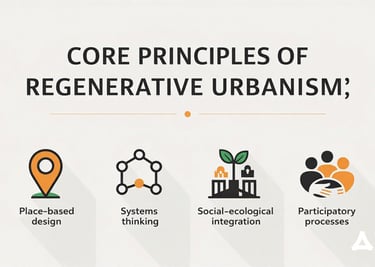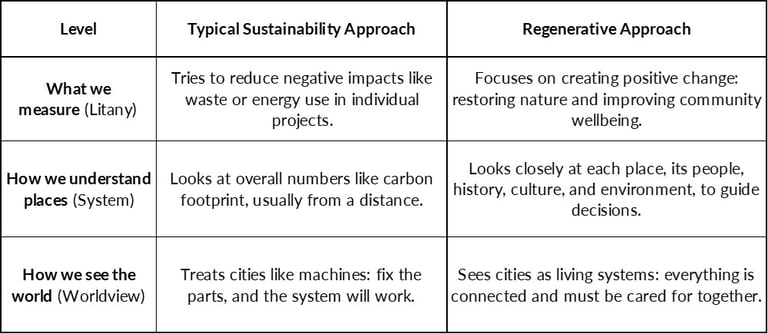What Is Regenerative Urbanism — And Why Do Cities Desperately Need It?
Discover the meaning of urban regeneration, why our cities urgently need it, and how this blog explores the complex journey of sustainable city transformation—from grassroots initiatives to scientific knowledge.
Marie Urfels
5/8/20246 min read


Cities are at a crossroads. Despite decades of sustainability efforts, from green buildings and carbon targets to circular economy initiatives, urban areas remain at the forefront of climate change, biodiversity loss, and social inequality.
Cities already house more than half of the global population, and this is projected to rise to nearly 70% by 2050. They consume 78% of the world's energy and produce 75% of global greenhouse gas emissions. Urbanization drives air pollution, habitat destruction, and resource depletion.
Cities are both a major source of today’s environmental and social challenges, yet they boiling for solutions. With sustainability initiatives blossoming across urban regions with the main intention to “do less harm” the reality is clear: despite immense efforts and measurable improvements, we remain far from a sustainable urban future.
What are current approaches missing? And how can we build on them to move toward something more transformative?
This is where regeneration comes in. Regenerative urbanism is about doing more good, not just minimizing harm. It pushes beyond sustaining current systems and asks instead: How can our cities actively heal and enhance the social and ecological systems they are built on?
From “Less Bad” to “More Good”: The Shift Toward Regeneration
For years, cities around the world have put immense work into making our cities more sustainable. We’ve seen impressive progress:
Improvements in air quality, public transit, and waste management
A shift toward renewable energy and green infrastructure
Better tracking of equity and environmental performance, especially through tools like the Urban Environment and Social Inclusion Index (UESI) and the Arcadis Sustainable Cities Index
Top-performing cities (often in Europe) now show higher tree cover, better access to public transit, and reduced pollution. Reports from the UN Habitat and Arcadis highlight areas of progress, greener streets, cleaner air, smarter waste systems.
Yet, across nearly every assessment, one message stands out:
Despite these efforts, there remains a significant gap between where we are and where we need to be to meet the 2030 Sustainable Development Goals.– Arcadis Sustainable Cities Index 2024
Another report, Cities and Climate Action by UN Habitat, underscores the same concern: urban climate action today doesn’t reflect the scale or urgency of the crisis.
Even after attending the Urban Summit in Brussels in 2023, one conclusion was hard to ignore: despite the energy, funding, and numerous innovative projects, the broader picture remains fragmented. Without a systemic lens, we’re only fixing parts and pieces, not transforming the whole.
Why Cities Need More Than Technology
and Policy
Yes, we’ve made progress. Technology and data have helped us measure and manage many aspects of urban life. But even with smarter sensors and AI-driven dashboards, the question remains: Are we just sustaining a flawed system?
Too often, sustainability has become about maintaining the status quo, slowing damage, or mitigating harm. It operates within a worldview where nature and cities are separate, and people are seen as neutral actors, not integral participants in ecosystems.
This technical, siloed mindset limits our capacity to design truly sustainable futures. With the increasing recognition of the limitations of traditional sustainability practices, we realize that it requires a shift in mindset and structures. Technological knowledge is still extremely valuable, don’t get me wrong, but we need to apply it in a more systemic way to truly create change. As awareness of these limitations grows, we see a trend emerging toward regeneration.
What Is Regenerative Urbanism?
Regenerative urbanism offers a new way forward, one that sees cities as living systems, deeply interconnected with nature, culture, and community. It’s not about reducing negative impact. It’s about creating net-positive outcomes as Camrass (2021, 2023) highlights .
Imagine cities that leave behind:
Cleaner air than they started with
More biodiversity, not less
Stronger community connections
Greater equity and well-being for all
It means starting with the story of a place, its history, geology, biology, and communities, and planning from that foundation up, rather than imposing top-down targets that miss the nuances of lived experience (Camrass, 2023).
Core Principles of Regenerative Urbanism:
Place-based design: Honor the uniqueness of each place, its people, culture, and ecosystem.
Systems thinking: Understand and design for the interdependence between infrastructure, people, and natural systems.
Social-ecological integration: Reconnect what has long been separated, the city and the natural world.
Participatory and adaptive processes: Engage communities early, meaningfully, and continuously. Support agency of communities. Build cities with, not just for, their residents.
Why Sustainability Alone Isn’t Enough
Too often, sustainability gets lost in vague language, short-term checklists, and disconnected policies. Here’s where regenerative urbanism offers an upgrade:
Challenges and Opportunities in the Urban Context
Regeneration in cities holds immense promise, but it also carries real risks. Without a systems lens, we risk reinforcing the very patterns we aim to transform. Cities aren’t just clusters of buildings. They’re living socio-ecological systems where people, infrastructure, ecosystems, and cultures are deeply intertwined. Regeneration must reflect that complexity.
UN-Habitat’s Inclusive Communities "Thriving Cities flagship programme" acknowledges some of these interconnections, identifying land, community, and environment as key themes. But the framing still leans heavily on socio-economic concerns. The environment is often treated as a passive backdrop, something to be cleaned up or managed, rather than a living system to restore, reconnect with, and co-evolve alongside. Community participation is encouraged, yet true local leadership and grassroots innovation are rarely centered. Land remains framed largely as an economic asset, not as a shared commons, cultural foundation, or ecological base.
If we don’t rebalance these narratives, if we fail to embed ecological thinking and community sovereignty into regeneration, we risk falling short of the transformation our cities need.
And regeneration is no easy task. Urban environments are complex, multilayered, and fast-moving. Cities are densely built, socially and culturally diverse, and often politically fragmented. There’s constant pressure for growth. And long-standing systems can be slow to change.
Yet this is exactly where regeneration matters most, where it can have the biggest impact. Urban areas already house more than half the global population. They are engines of creativity, culture, and innovation. With the right political will, financial tools, structural support and strong communities, cities can shift from extractive systems to regenerative ones.
But that requires a new perspective, one that sees cities not just as sites of consumption and production, but as places for healing, co-creation, and long-term resilience.
Why Regenerative Urbanism Matters Now
We’re facing overlapping challenges: climate instability, biodiversity loss, growing inequality, housing shortages, (mental) health problems, and rising loneliness in Western cities. These issues are deeply interconnected, and they’re all converging in our cities.
And yet, regenerative urbanism offers something different: hope. Not the naive kind but a grounded, actionable vision for transformation.
This isn’t about having the perfect plan. It’s about a mindset shift. About rethinking not just how we build, but why we build and for whom.
Let’s build cities that don’t just sustain life, but restore, regenerate, and connect all life.
This blog invites you to join us on a journey to explore regenerative urbanism through research, knowledge sharing, community initiatives, policies, and practices.
Sources:
Arcadis. (2024). Sustainable Cities Index 2024. Retrieved from Arcadis Sustainable Cities Index
Camrass, K. (2021). Urban regenerative thinking and practice: A systematic literature review. Building Research & Information, 50(3), 339–350. https://doi.org/10.1080/09613218.2021.1922266
Camrass, K. (2023). Regenerative urbanism: A causal layered analysis. Foresight, 25(4), 502–515. https://doi.org/10.1108/FS-11-2021-0227
Data-Driven EnviroLab. (2024). The 2024 Urban Environment and Social Inclusion Index. Chapel Hill, NC, University of North Carolina at Chapel Hill.
The Really Regenerative CIC, with Regen Labs, Australia. (2024) Place-based
Community-Led Regeneration: A study of the conditions of place, qualities and capabilities of regenerative practitioners likely to enable place-based community-led regeneration, for Joseph Rowntree Foundation - Emerging Futures Team
United Nations Human Settlements Programme (UN-Habitat). (2021, December 1-2). Urban Regeneration as a Tool for Inclusive and Sustainable Recovery: Report on the Expert Group Meeting. Hybrid event co-hosted by UN-Habitat and the Basque Country Government in Bilbao, Basque Country, Spain.
United Nations Human Settlements Programme (UN-Habitat). (2024, October 9). Executive Board of the United Nations Human Settlements Programme, 55th Meeting of the Ad Hoc Working Group on Programmatic, Budgetary and Administrative Matters: Urban Regeneration in the Context of UN-Habitat's Flagship Programme ‘Inclusive Communities – Thriving Cities’. Clarification Note.
United Nations Human Settlements Programme (UN-Habitat). (2024) World Cities Report 2024: Cities and Climate Action. United Nations Human Settlements Programme 2024.
Figure 1: Core principles of regenerative urbanism based on Camrass (2021, 2023) and The Really Regenerative CIC and Regen Labs (2024). Graphic created by vivago.ai


Table 1: From Sustainability to Regeneration — A Shift in Thinking, Adapted from Camrass (2023)